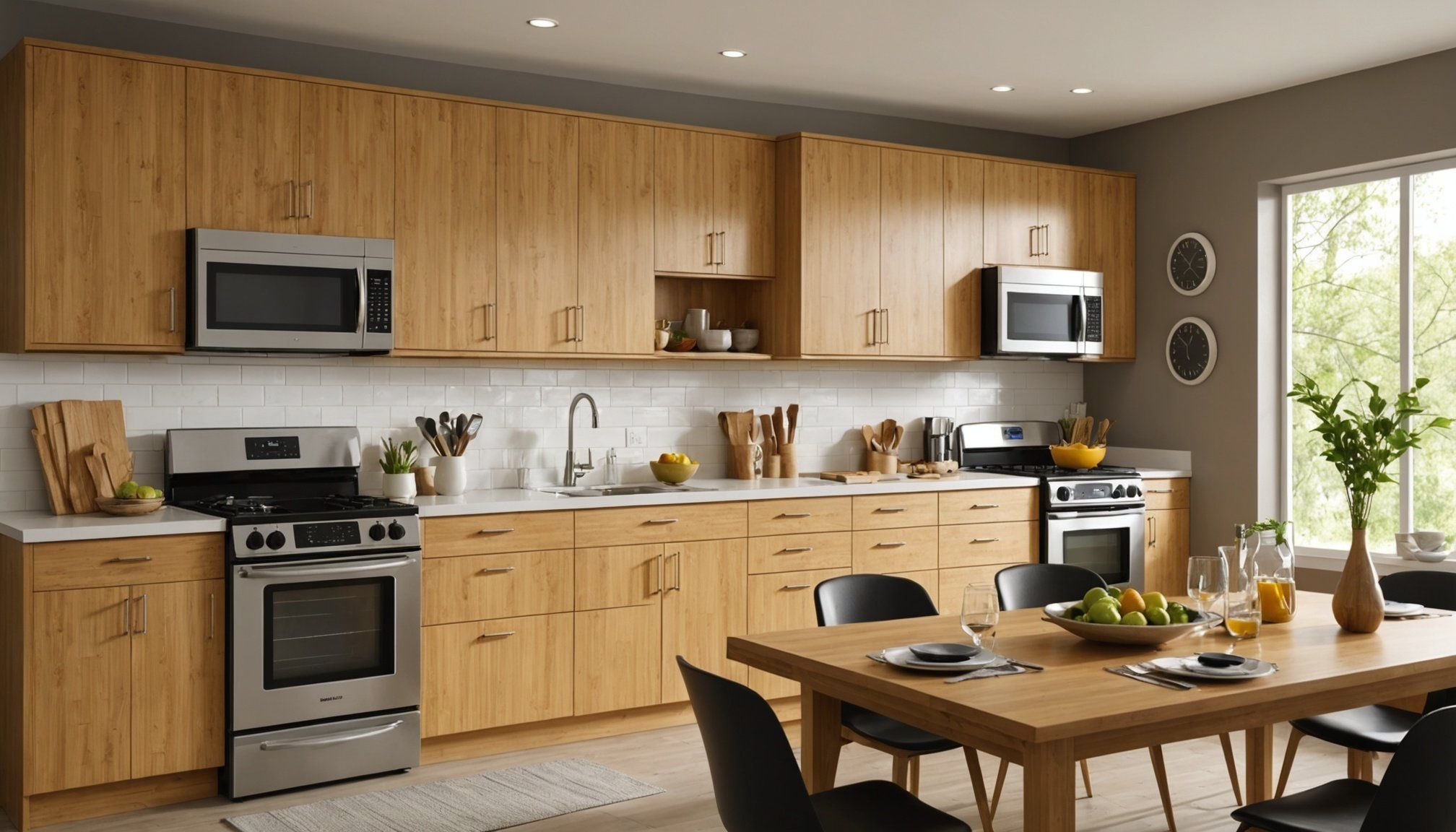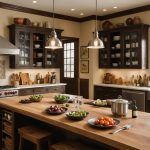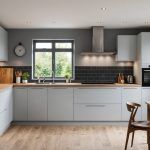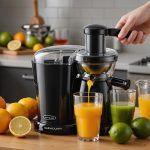Overview of Bamboo as a Sustainable Material
Bamboo, a versatile plant, is gaining popularity as an eco-friendly option in kitchen materials. Defined as a type of grass, bamboo is renowned for its rapid growth rate—some species can grow up to three feet in a single day. This makes bamboo an excellent material for sustainable design, as it regenerates much faster than traditional hardwoods.
One of the significant environmental benefits of using bamboo is its role in carbon sequestration. As a plant, bamboo captures carbon dioxide from the atmosphere, helping to reduce greenhouse gas levels. Additionally, because bamboo grows without the need for replanting, it requires less water and no harmful pesticides, further minimizing its environmental impact.
Topic to read : Transform Your Kitchen with Bamboo: Eco-Friendly Elegance and Modern Style
Comparing bamboo kitchen materials to traditional options such as wood and plastic, bamboo stands out for its renewability and biodegradability. Unlike hardwood species, which take decades to mature, bamboo reaches harvestable maturity within three to five years. This rapid growth cycle allows for a continuous supply without depleting resources.
Furthermore, bamboo’s durability rivals that of many conventional materials, making it suitable for a wide range of applications in the kitchen space. Its combination of eco-friendliness, strength, and aesthetic appeal make it an ideal choice for those committed to sustainable living.
Also to discover : Unlocking uk building regulations: the ultimate resource for your kitchen makeover journey
Benefits of Using Bamboo in Kitchen Renovations
Selecting bamboo for your kitchen renovation comes with numerous advantages, ensuring both functionality and style. At the forefront is bamboo’s durability. Bamboo is harder and denser than many hardwoods, making it an excellent choice for surfaces that require resilience. Unlike other materials that may wear quickly, bamboo offers a robust option for high-traffic kitchen areas.
Bamboo’s aesthetic versatility is another compelling benefit. Its natural grains and finishes provide a visual appeal aligned with both modern and classic designs. Whether you seek a minimalist aesthetic or a traditional look, bamboo seamlessly integrates into any kitchen style.
Additionally, bamboo offers ease of maintenance. To keep it in excellent condition, it requires only simple cleaning with a mild detergent and water. Its resistance to moisture and stains further simplifies upkeep, making it a practical choice for busy households.
Here are the primary advantages of using bamboo in your kitchen:
- Proven durability ensuring long-term use
- Wide aesthetic options fitting any design
- Easy maintenance requirements
These advantages illustrate why bamboo is becoming increasingly popular for kitchen renovations. Its combination of strength, beauty, and simplicity aligns perfectly with the needs of modern homeowners.
Design Inspiration for Bamboo Kitchens
In the realm of bamboo kitchen design ideas, modern themes have taken centre stage. With sleek lines and minimalist aesthetics, modern bamboo kitchens can transform any home into an elegant space. These designs typically emphasize subtlety and sophistication, using natural bamboo tones to create a calming environment. Homeowners looking for home decor inspiration can consider pairing bamboo with stainless steel appliances for a chic, contemporary feel.
Modern Bamboo Kitchen Designs
Modern bamboo kitchens often embrace open layouts, allowing for a seamless flow between cooking and dining areas. Integrating bamboo into cabinetry or flooring enhances the kitchen’s natural vibe. Such designs might incorporate muted colour palettes, like greys and whites, that highlight bamboo’s earthy hues.
Rustic Bamboo Aesthetics
For a touch of the countryside, rustic bamboo kitchens spotlight the wood’s grain and texture. These designs may include elements like exposed beams or farmhouse sinks, which harmonize with bamboo’s organic feel. Darker finishes can be used to accentuate the material’s rich tones.
Combining Bamboo with Other Materials
Bamboo pairs well with materials like granite or quartz. This combination not only enhances durability but also introduces a striking visual contrast. Consider adding metallic fixtures for a modern twist or ceramic elements for timeless appeal. Such versatile combinations ensure your bamboo kitchen remains both functional and stylish.
Tips for Selecting Bamboo Products
Choosing bamboo products comes with its own set of criteria, especially when considering bamboo kitchen essentials. The key factors to consider include type of bamboo, quality indicators, and intended use.
Factors to Consider
When selecting bamboo items for your kitchen, prioritize durability and sustainability. Opt for harder bamboo types such as Moso or Dendrocalamus, as they are noted for their strength and longevity. Understanding the type of bamboo used can elevate the quality of your kitchen experience.
Best Types of Bamboo for Kitchen Use
Bamboo kitchen essentials crafted from Moso bamboo are highly regarded due to their thick culms and tough structure. This makes them perfect for cutting boards and utensils. Moso is not only sturdy but also renewable, growing easily without pesticides.
Recognizing Quality Indicators
Quality indicators in bamboo products are crucial when making a choice. Look for bamboo with a smooth, polished finish and closely spaced nodes. High-quality bamboo has minimal splinters and showcases an even color with no visible cracks.
When choosing bamboo products, being informed about the type of bamboo and its quality indicators can make all the difference in your kitchen. Emphasizing these aspects ensures you select products that are not only functional but also long-lasting and eco-friendly.
Eco-Friendly Practices When Using Bamboo
Embracing sustainable kitchen practices begins with understanding how to integrate bamboo into your home responsibly. By ensuring your bamboo is sourced from responsibly-managed plantations, you contribute to an eco-friendly design while supporting global environmental efforts. Responsibly-sourced bamboo is cultivated without compromising the ecosystem, safeguarding biodiversity and reducing carbon footprints.
Besides bamboo, consider incorporating other eco-conscious choices in the kitchen. Opt for energy-efficient appliances, reusable packaging, and eco-friendly cleaning agents. These small adjustments, combined with the use of bamboo, significantly lower household waste and reduce your kitchen’s overall environmental impact.
Supporting sustainable brands not only reflects ethical consumerism but also encourages industry-wide responsibility. When brands align their production methods with eco-friendly standards, they promote resource conservation and sustainability. Sustainable brands are committed to using materials like bamboo, ensuring their practices minimize environmental harm and foster a healthy planet.
- Key benefits of sustainable practices:
- Reduction in ecological footprint
- Contribution to biodiversity conservation
- Encouragement for brands to innovate sustainably
Integrating sustainable kitchen practices with bamboo enhances not only the aesthetics of your home but also its environmental contribution, making your culinary space part of a more extensive network of eco-friendly living.
Cost Considerations for Bamboo Renovations
When contemplating bamboo renovations, one must weigh the initial costs against potential long-term savings. Although bamboo can be more expensive upfront than some materials, its durability often results in longer-lasting installations, reducing the need for frequent replacements. The sustainability and rapid regeneration of bamboo contribute to lower long-term maintenance costs, making it a savvy investment.
For those concerned about budget, consider cost-effective bamboo alternatives. Engineered bamboo, for instance, is generally less expensive than solid bamboo, yet still retains the aesthetic appeal and durability desired in a renovation project. Additionally, utilising bamboo for smaller, accent-based projects—like kitchen backsplash or furniture—can keep costs budget-friendly while still enhancing your space with bamboo’s unique charm.
Effective budget management tips for bamboo-centric kitchen renovations are crucial. Start by setting a clear budget, identifying priorities, and sticking to them. Consider steps like:
- Seeking out bulk material purchases
- Opting for DIY elements if feasible
- Negotiating labour costs
By carefully balancing initial expenses with the long-term benefits, and employing strategic budget management, homeowners can enjoy both the elegance and sustainability of bamboo without breaking the bank. These steps ensure a satisfying and financially sound renovation journey.








